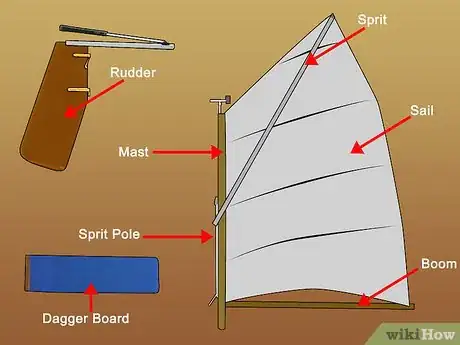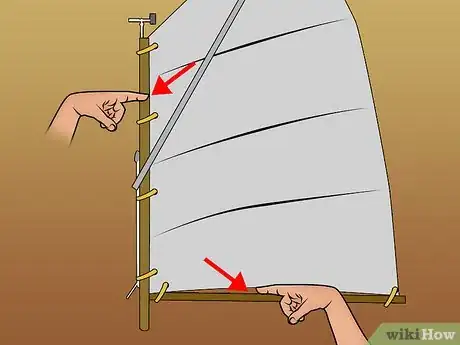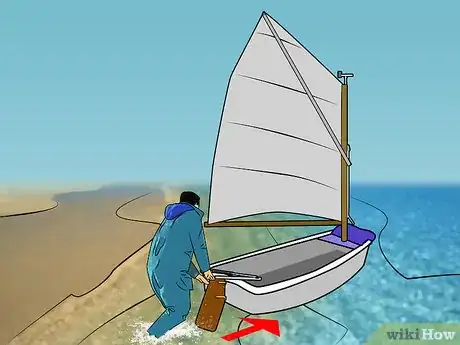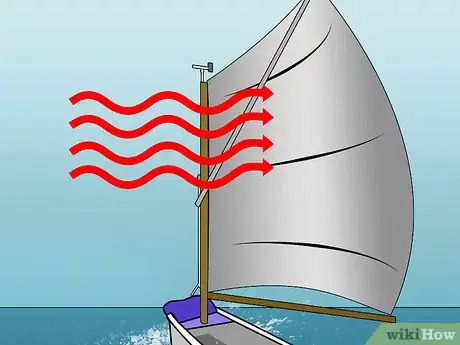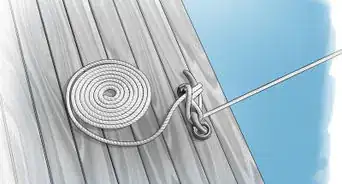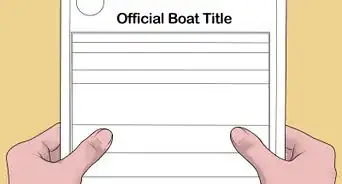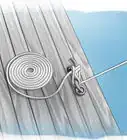wikiHow is a “wiki,” similar to Wikipedia, which means that many of our articles are co-written by multiple authors. To create this article, 21 people, some anonymous, worked to edit and improve it over time.
This article has been viewed 41,276 times.
Learn more...
Sailing is fun and easy if you know how. Optimists are safe, simple boats designed for children who are learning how to sail. Their main advantage is that there are extensive opportunities for children to take optimist sailing to a very advanced level. Hugely popular, there are optimist national teams in many countries and Optimist World Championships are held annually. On a more local level, there are thousands of smaller competitions available which are organized by yacht clubs and sailing programs.
Steps
-
1Obtain all of the equipment needed (a rudder, dagger board, sail, mast, boom, and spirit pole etc). These should all come with the boat. If you are buying the boat new, a decent seller will always include rigging equipment such as lines (ropes) and blocks (pulleys). These are extremely expensive for what they are and also difficult to assemble if you buy them separately. It is also recommended to buy a dolly with the boat as well. Optimists are heavier than they look and if you are launching them from a beach, then dragging them on the sand removes the gel coat (the smooth finish on top of the fiberglass) and drastically slows you down in the water..
-
2Assemble the sail. The sail ties should only be loose enough so that you can put a finger between them and the boom (also ensure that the sail can move over the boom without being caught on fittings). The mast ties should be tighter than this (so that the edge of the sail is up against the mast). Put the sail in the mast step (the metal fitting at the front of the boat) before putting up the spirit pole. The adjustments on the sail should be tightened/loosened so that no creases are visible. Generally, heavier wind requires tighter adjustments.Advertisement
-
3Launch the boat. Slip it into the water and point it towards the wind. While standing on the sea floor or on the dock, clip the rudder in. Line up the bottom pin to its hole first (as this one is longer), making sure the safety catch will prevent the rudder from coming out of the two fittings. Put the daggerboard into its trunk, but do not push it down completely yet. In one movement, push the boat away from the beach or dock and climb in. The wind may be coming from off-shore, cross-shore, or on-shore. In each case there will be directions and places the boat can sail. There are (Go zones) and other zones that the Optimist cannot or should not sail from called (No-Go zones).
-
4Position yourself on the rail so that you are facing the bow (the smaller end) of the boat. Your front foot should be up against the bulkhead (the foot high separator halfway up the boat).
-
5Get hold of tiller extension with the hand closest to the stern (back) of the boat and hold it as if it is a microphone. Hold the main sheet with your other hand. Make sure you do not wrap it around your hand because you may need to release it quickly to stop. Pull in the main sheet until the sail fills and stops luffing (flapping back and forth). Put down the dagger board completely when you are in deep enough water.
-
6Make sure the sail is always trimmed (adjusted) so that it will catch the wind. Never sail directly into the wind. Pulling the tiller towards you will point the boat further away from the wind and pushing it away will point the boat more towards the wind if you are sitting on the opposite side to the sail. When going upwind, pull in the sail so that the end of the boom is at the back corner of the boat. When going downwind, let out the sail so that it is perpendicular to the rail. Always watch the sail and the wind direction so that you will be forewarned if the sail wants to come across the boat towards you. If the boom hits you, it will hurt!!
Community Q&A
-
QuestionDo I go by myself?Yes. Unless stated otherwise in the owner's manual, an optimist will be designed to only carry one person. Most can carry two; however, you will not be covered by the warranty, and you will notice a drop in top speed due to the increased drag of the displacement-style hull.
-
QuestionI need help sailing downwind?
 Rebekka RianCommunity AnswerYou can't actually sail directly against the wind, but you can try to sail in a zig-zag pattern.
Rebekka RianCommunity AnswerYou can't actually sail directly against the wind, but you can try to sail in a zig-zag pattern.
Warnings
- Sit on the opposite side of the sail. The fastest position for an optimist is when all four corners of the hull are in the water. If there is a light wind, you may find that you have to lean towards the sail in order to achieve this. This helps to keep the boom from coming towards you if the wind is not heavy enough to keep it out.⧼thumbs_response⧽
- Ensure you have a bow line with a bowline knot at the end attached to your mast step. Do not thread this through the drain hole in the middle of the rail at the front of the optimist. Doing so will gradually wear away the rope during towing and may lead to it snapping undertow. The severed end will snap back and may lead to serious injury of the sailor, particularly risking eye injury. It will also prevent fast evacuation in the event of a thunderstorm.⧼thumbs_response⧽
- As with all water sports, sailing can become dangerous when the weather is not favorable. If you are caught out in a thunderstorm, capsize (turn over) your boat immediately so that the mast is underwater and perpendicular to the sea floor. Stay with your boat. Do not go out if you believe that the wind conditions are too difficult for you, however, you should always push yourself to manage in conditions slightly more difficult than you are used to because this is how you will improve.⧼thumbs_response⧽
- Even if there is light wind and clear blue skies, you should always wear a flotation aid.⧼thumbs_response⧽
